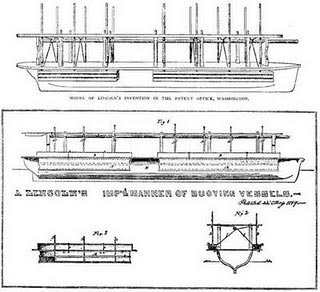
Nantucket Camel Ride
Today is the anniversary of Abraham Lincoln’s birthday on February 20th, 1809. He is know for rising from poverty, working as a rail splitter, and as a self-taught country lawyer before being elected as a congressman and ultimately as president. As commander in chief during a bloody civil war, he preserved the union and became known as the “Great Emancipator’ for his role in ending slavery.
Lincoln is less well-known as an inventor, yet he is the only president in this country’s history to have a patent issued in his name. Here is an updated repost of the tale of a patent granted to Abraham Lincoln for a device to lift boats and ships over sandbars.
In the early 1800s, the entrance to the harbor of the great whaling port of Nantucket had shoaled in. Fully loaded whaling ships could not cross the bar and return to the docks beyond Brandt Point. For years the ships anchored offshore and were lightered, the barrels of whale oil loaded into smaller boats that could make it across the bar.
To avoid the considerable time and expense of lightering, an ingenious group of Nantucketers built a camel, which consisted of a pair of hollow barges connected by chains, which acted as a floating drydock to lift the whaling ship up and over the bar. The twin barges were partially filled with water, then brought on either side of the whaling ship. The chains between them were tightened and the barges were pumped dry.
The buoyancy of the “camel” would lift the whaling ship so the camel and the ship together could cross the bar. The first ship to ride “over the bar” on the camels was the 257-ton whaler, Peru, returning in 1839, from a successful, 3-1/2 year, voyage in the Pacific. Nantucket’s own Joshua Coffin commanded the ship right up to the wharf, the proud captain bringing his ship, cargo and crew all the way home.
So what does this have to do with Abraham Lincoln? As previously noted, Lincoln is the only US President to have ever been granted a patent. He invented an improved integrated camel to lift boats and ships over sandbars in rivers.
On May 22, 1849, he was granted Patent No. 6469 by the U.S. Patent Office (USPO) in Washington, D.C. This boat model, submitted with the drawings of his idea, is inscribed “Pat./May 22/49/Abram Lincoln” on the surface of the upper deck. According to a Lincoln biographer, the President visited the Patent Office during his presidency (1861–1865) and inspected his model. His considerable talents lay elsewhere, and the idea he patented was never formally applied in the construction of a watercraft.

Part of his application read, “Be it known that I, Abraham Lincoln, of Springfield, in the county of Sangamon, in the state of Illinois, have invented a new and improved manner of combining adjustable buoyant air chambers with a steamboat or other vessel to enable their draught of water to be readily lessened to enable them to pass over bars, or through shallow water, without discharging their cargoes…”

